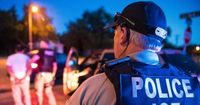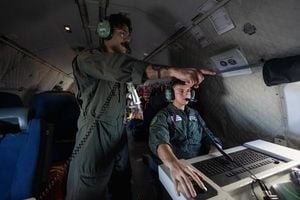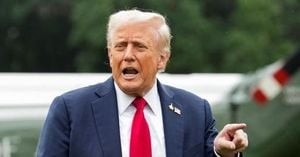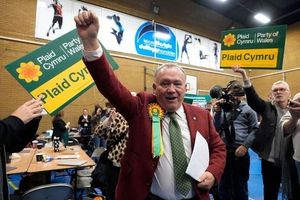On a brisk Thursday evening in late October 2025, the Little Village neighborhood of Chicago became the epicenter of a dramatic confrontation between federal law enforcement and local residents. The clash, which unfolded at the intersection of 27th and Whipple, has since spiraled into a contentious legal battle and ignited fierce debate over the use of force, civil rights, and the boundaries of federal intervention in local matters.
According to reports from both local media and the Department of Homeland Security (DHS), a crowd estimated at 75 to 100 people gathered as Border Patrol agents, led by Chief Greg Bovino, conducted enforcement operations in the area. What began as a tense standoff quickly escalated. DHS officials allege that the crowd—described by Assistant Secretary for Public Affairs Tricia McLaughlin as "rioters"—surrounded agents, blocked their vehicles with a large box truck, and launched commercial artillery shell fireworks at law enforcement. The situation, as depicted by DHS, became increasingly volatile, with rocks and other objects hurled at agents. One rock reportedly struck Chief Bovino in the head.
Yet, the narrative is far from unanimous. Local officials and civil rights advocates are challenging the federal account. Alderman Byron Sigcho-Lopez, who was present during the raid, flatly denied DHS claims that fireworks were fired at agents. Speaking to WTTW News, Sigcho-Lopez insisted, "No one shot any kind of fireworks at federal agents." This contradiction between federal and local accounts has only intensified scrutiny of the events and the subsequent actions taken by law enforcement.
The heart of the controversy lies in the use of tear gas by Chief Bovino during the raid. Just two days prior, U.S. District Court Judge Sara Ellis had issued a clear order prohibiting federal agents from deploying tear gas and other weapons against journalists, protesters, or anyone not posing an immediate threat to immigration enforcement agents. The order, prompted by concerns raised by the Chicago Headline Club, Chicago Newspaper Guild Local 34071, Block Club Chicago, and other media organizations, stipulated that agents must issue two warnings before using tear gas or chemical sprays, except in cases of immediate danger.
Despite this, video evidence submitted to Judge Ellis shows Chief Bovino deploying at least two canisters of tear gas into the crowd. Notably, the footage does not capture any instance of Bovino being struck by an object before the tear gas was used, casting doubt on DHS assertions about the sequence of events. This discrepancy has fueled allegations by lawyers for the Headline Club and other plaintiffs that Bovino violated the court order. In their petition to Judge Ellis, they expressed concern that the federal government "was simply ignoring your order," urging the court to "conduct an inquiry into this incident and order relief that the court deems proper," given what they characterized as the "flagrancy of the apparent violation."
Judge Ellis responded swiftly and decisively. Less than 24 hours after the incident, she ordered Chief Bovino to appear in her courtroom in person at 10 a.m. on Tuesday, October 28, 2025. The judge's intervention underscored the seriousness of the allegations and the potential ramifications for federal law enforcement operations in Chicago and beyond.
In an interview with CBS News published Friday, Chief Bovino defended his actions and those of his agents, stating, "The use of force that I’ve seen has been exemplary — the least amount of force necessary to accomplish the mission. If someone strays into a pepper ball, then that’s on them. Don’t protest and don’t trespass." His comments, while unapologetic, have drawn criticism from civil liberties advocates who argue that the right to protest government actions is enshrined in the First Amendment and must be protected, even amid heated confrontations.
The Department of Homeland Security has doubled down on its narrative. In a post on X (formerly Twitter), the agency declared, "Law and order will triumph in Chicago," signaling its intent to continue enforcement operations despite what it describes as "increasingly violent tactics by protesters." McLaughlin elaborated, "Border Patrol agents repeated multiple warnings to back up and that chemical agents would be deployed if warnings were ignored. Riot control measures were deployed, including by Chief Bovino, and arrests were made. Agents properly used their training. The use of chemical munitions was conducted in full accordance with [U.S. Customs and Border Protection] policy and was necessary to ensure the safety of both law enforcement and the public."
However, skepticism about the federal government's account extends beyond local activists. In a separate but related legal case challenging President Donald Trump’s earlier deployment of 700 National Guard troops to Chicago, U.S. District Court Judge April Perry remarked that federal officials’ assertions of "serious and coordinated violence by protestors" were "simply unreliable." This judicial skepticism adds weight to the calls for greater oversight and transparency in federal law enforcement activities.
The events in Little Village are not isolated. In the 23 days leading up to October 24, 2025, DHS agents have deployed tear gas against crowds protesting immigration enforcement operations in at least five Chicago neighborhoods: Logan Square on October 3, Brighton Park on October 4, Albany Park on October 12, East Side on October 14, Little Village on October 23, and Lakeview on October 24. Each incident has further polarized public opinion, with some residents and officials decrying what they see as excessive force and others insisting that federal agents are simply upholding the law amid challenging circumstances.
Adding to the complexity, a Border Patrol transport van carrying detained individuals was reportedly attacked by the crowd during the Little Village incident, but agents were able to secure the van and bring it into the perimeter. The DHS maintains that all actions taken were within agency policy and necessary for the safety of both law enforcement and the public.
As the city braces for Chief Bovino’s court appearance, the stakes could hardly be higher. The outcome of Judge Ellis’s inquiry may set important precedents for how federal agencies operate in urban environments, especially when local sentiment is sharply divided. The case also raises broader questions about the balance between public safety, civil liberties, and the accountability of those wielding federal power on city streets.
For now, Chicago remains on edge, with residents, activists, and officials alike awaiting answers—and perhaps, a measure of justice—from the federal courts. The coming days promise to be pivotal, not just for those directly involved, but for the ongoing national conversation about protest, policing, and the rights of citizens in the face of government authority.




